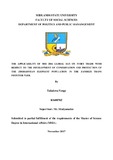Please use this identifier to cite or link to this item:
https://cris.library.msu.ac.zw//handle/11408/3670Full metadata record
| DC Field | Value | Language |
|---|---|---|
| dc.contributor.author | Venge, Tafadzwa | - |
| dc.date.accessioned | 2019-06-10T13:16:23Z | - |
| dc.date.available | 2019-06-10T13:16:23Z | - |
| dc.date.issued | 2017 | - |
| dc.identifier.uri | http://hdl.handle.net/11408/3670 | - |
| dc.description.abstract | The Zambezi Trans frontier park is one of the world’s largest conservation areas and is one of the homes for the African elephant, scientifically known as the loxodonta Africana. The African elephant is one of earths largest land mammals and also one of the worlds objectified creatures. Over the years since 1970 the global demand for ivory has risen to levels that are threatening the extinction of elephants due to poaching. Poaching has resulted in massive decline, by almost half in the elephant population in Africa in the period 1970 to 1985. Convention on International Trade in Endangered Species of Wildlife Fauna and Flora (CITES) in 1989 had the majority of its 115 member countries deciding to completely ban the international trade of ivory in an effort to restore the elephant population to healthy levels. However in 1996 and 1997, countries such as Zimbabwe, Botswana and Namibia had the ban partially lifted due to their large elephant populations which were even increasing beyond capacity. In 2016, at the CITES 17th Conference Of Parties (COP17) held in South Africa, CITES endorsed the closure of all domestic markets on ivory despite arguments by Zimbabwe, Botswana, South Africa and Namibia who had proposed to resume ivory trading to beef up their conservation budgets. Such a decision by CITES has disastrous consequences for countries with large elephants populations with Zimbabwe being one of them. The ban which comes with an absence of any regular trade has removed incentives for locals to conserve elephants. Such a situation has caused many parks to be surrounded by hostile rural communities who are trying to recover their wasted investments in elephants. The Zambezi Trans frontier park will lose out as countries like Zimbabwe have protected area management schemes that are self-funding in nature and thus the country’s resource protection is financed through the sustainable utilisation of various wildlife resources. The African elephant for one is Zimbabwe’s biggest draw card species from a hunting perspective and thus the ban on all trade will result in non-utilisation of the country’s natural resources. | en_US |
| dc.language.iso | en | en_US |
| dc.publisher | Midlands State University | en_US |
| dc.subject | Conservation | en_US |
| dc.subject | Ivory | en_US |
| dc.title | The applicability of the 2016 global ban on ivory trade with respect to the development of conservation and protection of the Zimbabwean elephant population in the Zambezi Trans Frontier Park | en_US |
| item.languageiso639-1 | en | - |
| item.grantfulltext | open | - |
| item.fulltext | With Fulltext | - |
| Appears in Collections: | Master of Science in International Affairs Degree | |
Files in This Item:
| File | Description | Size | Format | |
|---|---|---|---|---|
| Tafadzwa Venges Dissertation.pdf | Full Text | 1.09 MB | Adobe PDF |  View/Open |
Page view(s)
184
checked on Nov 19, 2025
Download(s)
106
checked on Nov 19, 2025
Google ScholarTM
Check
Items in MSUIR are protected by copyright, with all rights reserved, unless otherwise indicated.



